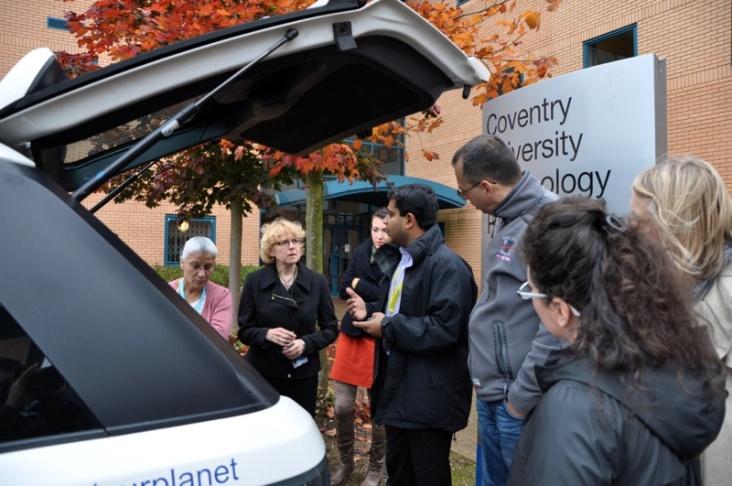
27 minute read
Anne Äyväri, “Towards a customer centric tool for building value propositions
Anne Äyväri a
Advertisement
a
Laurea University of Applied Sciences, anne.ayvari@laurea.fi
Abstract
The insights on the recent conceptualisations on value, value creation, and value proposition are reflected on the tools for building value propositions. The tools are the Value Proposition Builder™, the People Value Canvas, and the Value Proposition Canvas. The first tool represents the firm-centric approach focusing on building value propositions for the current offerings. The latter two are more customer-centric, and understand value as value-in-use depending on the time and context of the usage. It is concluded that the interactional and networked nature of value and the understanding of all the social and economic actors as resource integrators are missing in the present frameworks for building value propositions. A Living Lab as an open ecosystem is suggested as an excellent environment to study and develop the value proposition tools further in order to embed the missing perspectives, and to end up constructing more user-centric value propositions simultaneously considering the whole service ecosystem as a space for negotiating the resource sharing.
Key words
Value, value propositions
1 Introduction
Activities related to building and testing value propositions and business models are quite familiar to anyone involved in innovation processes in Living Labs or start-ups. Often we take the tools available as for granted without considering their premises, not to mention the consequences of the premises. This article takes a closer look at three tools for building value propositions. The aim is to analyse whether the tools are aligned with the most recent conceptualisations on value, value creation and value propositions, and finally give some suggestions how the tools should be developed further.
The article is structured as follows. First, we examine the nature of value. Second, we present a brief review of the development of the value proposition concept. Third, we introduce three tools for building value propositions. Fourth, we use the insights on the recent conceptualisations on value and value propositions to reflect on the three tools from the perspective of user-centric innovation processes. Finally, we discuss the ideas how to develop the tools for building value propositions especially in the context of Living Labs.
In the traditional marketing literature based on the production oriented perspective value has been seen in terms of value delivery, reflecting value as packed in the object produced by the provider (Heinonen et al., 2013, Vargo and Lusch 2004). Value has thus been seen as something tangible or easily measurable (Heinonen et al., 2013), and it has been defined in terms of “exchange-value” (Vargo and Lusch, 2004). Hence, value has been conceptualized as a rather objective and static construct. In the Goods-Centered Dominant Logic value is determined by the producer, and the role of the customer is to be a passive buyer (Helkkula et al., 2012) or the recipient of goods, thus the recipient of the value the producer delivers (Vargo and Lusch, 2004).
The Service-Centered Dominant Logic (later S-D logic) for marketing implies that value is defined by and co-created with the consumer rather than embedded in output; it is perceived and determined by the consumer on the basis of “value-inuse” (Vargo and Lusch 2004, p. 6, 7). Thus, there is no value until an offering is used, because experience and perception are essential to value determination (Vargo and Lusch, 2006). The co-created nature of value implies that value creation is interactional (Vargo & Lusch, 2008).
Although the S-D logic emphasise the value-in-use Heinonen at al. (2013) criticize the approach for its short-term time-frame, and they propose a longitudinal experience perspective stressing value as part of the customer’s dynamic reality recognising value before, during, and after customer experiences as part of customers’ cumulated life and reality. It has been suggested that also the imaginary future experience construct value (Helkkula et al., 2012).
The contextual nature of value has been discussed by many researchers. Customer experience (or value-in-use) is always influenced by the customer’s internal and external context (Heinonen et al., 2013; Helkkula et al. 2012), and therefore value is situational (Holbrook, 2006). In 2008 Vargo suggested that the term value-in-use should be replaced by the term value-in-context to reflect the fact that value is always uniquely and phenomenologically determined by the beneficiary. Edvardsson et al. (2011) agree on the contextual nature of value, and they contend that value should be understood as value-in-social-context because value is a social construction; it has a collective and intersubjective dimension (see also Helkkula et al., 2012). They claim that value is shaped by social forces, is reproduced in social structures, and can be asymmetric for the actors involved. Likewise Vargo and Lusch (2014) maintain that the institutions –norms, rules, symbols, and so on –created by the actors make joint value creation possible. Moreover Grönroos and Voima (2013) conclude that the context –whether social, physical, temporal, and/or spatial determines the experience of value-in-use.
The networked nature of value has recently gained more and more attention. The customer’s value creation process is influenced by a wider customer network or ecosystem, which consists of other customer-related actors (e.g. family, friends), beyond the firm’s control (Grönroos and Voima, 2013). One of the basic premises of the S-D logic (Vargo and Lusch, 2008) is that all social and economic actors are resource integrators, which implies the context of value creation is networks of networks as consumption/usage is about integrating resources acquired from
different sources into a usage process. In their most recent article Vargo and Lusch (2014, p. 2–3) point out that the dynamic, interdependent, networked nature of value creation (i.e. co-creation) among actors implies the service ecosystem rather than individual (e.g. the firm) or dyadic actors (e.g. firm–customer) is the appropriate unit of analyses for understanding value creation.
3 The value proposition concept
It has been claimed that value proposition thinking is at the heart of any valuefocused organization because it sharpens the way organizations work by focusing activity so as to serve customers profitably (Barnes et al, 2009). The definition of value proposition has changed during the last two decades1as the understanding of the customer’s value creation processes has deepened. However, the popular text books written by both academics and consultants mostly rely on rather firm-centric definitions of value propositions. In fact, the study by Anderson et al. (2006) revealed that most managers in Europe and USA equate their list of benefits to their value proposition without much concern about their customers and competitors.
For example, Barnes and her colleagues (2009, p. 22, 28) cite Lanning (1998): A value proposition statement is the articulation of the measurable value of the experience that an organization or an individual will get from an Offering, where Value = Benefits minus Cost. A value proposition must include the following elements: 1) capability: what can you do for your customer, 2) impact: how that will help the customer to succeed, and 3) cost: what the customer must pay for the privilege. A value proposition articulates the essence of a business, defining exactly what the organization fully intends to make happen in the customer’s life.
Value Proposition is one of the building blocks of Business Canvas (Osterwalder et al., 2010). It describes the bundle of products and services that create value for a specific Customer Segment. Hence, Osterwalder and his colleagues (2010) argue that the firm creates and delivers value to the customers through a distinct mix of elements catering to that segment’s needs.
The lively discussion on the S-D logic (Vargo and Lusch, 2004, 2008) has grown interest in the redefinitions of the value proposition concept. In their seminal article in 2004 Vargo and Lusch argued that firms can only make value propositions but the consumer must determine the value and participate in creating it through the process of coproduction. Later this premise was slightly modified: The enterprise cannot deliver value, but only offer value propositions (Vargo and Lusch, 2008, p. 7). Based on the understanding of the co-created nature of value Grönroos (2011) argues that the firm can engage in customers’ value fulfillment during direct interactions, and thus the firm is no longer restricted to making value propositions only.
Frow and her colleagues (2011, 2014) have noted that most research on value propositions has focused on the narrow customer-firm perspective. However, some exceptions can be found: recruitment market, internal market, referral market, influence market, and supplier and alliance market value propositions (Frow and
1
See the most recent review of previous definitions of the value proposition concept in Frow et al. 2014.
Payne, 2011). In their most recent article, Frow et al. (2014, p. 14) define the value proposition concept in the broader context of a service ecosystem as follows: a dynamic and adjusting mechanism for negotiating how resources are shared within a service ecosystem. Reciprocal and co-created value propositions evolve through three broad stages: value propositions to customers, to key actors and within the service ecosystem.
4 Three tools for building value propositions
In this section we introduce three tools for building value propositions: Value Proposition Builder™ by Barnes et al. (2009), Value Proposition Canvas by Osterwalder et al. (2012), and People Value Canvas by Wildevuur et al. (2013).
4.1 Value Proposition Builder™ Value Proposition Builder™ by Barnes, Blake, and Pinder (2009, 30–31) is a six-step iterative process presented in Figure 1. Each element is viewed through the filter of responses already generated.
6. PROOF Substantiated credibility and believability of your offering

5. ALTERNATIVES AND DIFFERENTIATION How you are different from and better than the alternatives 1. MARKET The specific group of customers you are targeting

VALUE PROPOSITI ON


4. BENEFITS How your offering delivers clear customer value 2. VALUE EXPERIENCE Benefits minus costs, as perceived by customers


3. OFFERINGS The product/service mix you are selling
Figure 1. The Value Proposition Builder™ (Barnes et al., 2009, 31)
According to Barnes and her colleagues (2009, 62), a value proposition defines how an offering will benefit a market segment or customer, and at what cost. Hence it is logical to start by defining the market segment or customer types. The market analysis (ibid, 62–63) is suggested to start with firm-centric questions like “Where does our organization figure in the marketplace? Is it where we want to be? Which markets or customer types offer the best opportunities for profitable growth?” followed by more customer-centric questions like “What are the customer needs? What keeps them awake at night? What are their points of pain? What risks do the customers perceive when choosing our organization?”
The suggested questions (ibid, 73) on value experience focus on the experience gained when purchasing and using the present offerings on the market: “What are
the most important factors when your customers are looking to purchase (product /service)? Who is the best supplier of this experience? What do you specifically like about this supplier? What do you value beyond price/cost? What could we do to improve your experience of working with us?
The third stage concentrates on current offerings which have to be categorized and mapped to the Value Pyramid™ consisting of four layers: component (at the bottom), offer, solution, and co-created value at the top (ibid, 83). Barnes et al. (2009, 87) strongly emphasize that the benefits (the fourth stage) should be based tightly upon experiences of value by customers and staff. The core of the analysis of benefits is the so called benefits map presenting the core service, and its expected, augmented, and potential benefits (ibid, 88).
Barnes et al. (2009, 94) argue that firms are not competing against each other’s offerings but against their value propositions. For the customer, “do it yourself” or “do-nothing” are alternatives, too. All the suggested questions to be answered at the fifth stage are producer-driven, e.g.: “Which alternatives can deliver the best value to my customers? Are any of my competitors able to deliver this value cheaper, faster, and better than my organisation? What makes my organisation different from and better than my competition?”
The last stage of the Value Proposition Builder™ deals with backing up the value proposition with relevant, substantiated proof (ibid, 101–102). The following techniques are recommended to be used when providing evidence for the claims: case studies, books, articles, customer testimonials, and value calculators (total cost of ownership, TCO, or return on investment, ROI, or cost-benefit, C–B).
4.2 The PeopleValue Canvas
The Canvas was developed during an Ambient Assisted Living JP project called Express to Connect (2010–2013) with the aim to develop an ICT-based solution for strengthening social connectedness of older adults. The project was based on a user-driven methodology.
The People Value Canvas (PVC) consists of nine building blocks, describing the input that has to be provided in order to establish the value proposition (see Figure 2). This allows for holistic development and description of concepts, when the interdependencies between the different blocks are taken into consideration. On the one hand, the canvas helps structure users’ needs and preferences, the context and effect. On the other, it describes how a proposed new solution will meet userdriven criteria. (Wildevuur et al. 2013, p. 137.)
The understanding of people is the key issue in the People Value Canvas: the user is the expert on his own life and experience and should be driving the development process. The PVC is intrinsically linked to the development principles based on the Users as Designers -method (van Dijk et al. 2011), and ethnographic research methods. The first five building blocks present the user insights gained through ethnographic studies and co-creation sessions withthe users.
(3) Characteristics
(4) Motivation
(2) Needs (1) People
(6) Technology
(7) Processes
(8) Experiences
(5) Context


(9) Effect
Figure 2. The People Value Canvas (Wildevuur et al. 2013, p. 135)
The first building block, People, introduces the main characteristics of the target group, and the portraits. Much like a persona, a common interaction design tool, a portrait is a description of the user, but the construction of a portrait is always based on empirical data from the qualitative research rather than a fictive description. Portraits anchor the differences within the identified user needs, and they function as vehicles for empathy and identification, visual depictions of knowledge, and representations of certain market segments. (Wildevuur et al. 2013, p. 152.)
The next building blocks of PVC –Needs, Characteristics, Motivation, and Context, provide further insights of the users. The outcome-driven innovation approach (Ulwick 2009) maintains that the proper definition of “customer need” becomes clear when the job is the unit of analysis. Needs relate to how well the customer is getting a job done. A job is defined as the fundamental goals customers are trying to accomplish or problems they are trying to solve in a given situation (Ulwick & Bettencourt 2008a). The jobs can be divided into two main categories: functional and emotional jobs. Emotional jobs are related to the achievement of personal goals, and they are further subdivided into personal functions (how you want to feel in certain circumstances) and social functions (how you want to be perceived by others) (Wildevuur et al. 2013, p. 140).
The contents of the Characteristics block is not only limited to the attributes of the users. It answers to questions like “In what ways are they active and connected? What kind of competences do they have? Which fears? Which dreams? What kind of relationship do they have with technology?”. Motivation is what drives a person
to behave in a certain way, and is crucial component in setting and reaching goals. Motivations shed light on individual aspirations, and what people value. (Wildevuur 2013, p. 142–143.) The fifth building block, Context, refers to the everyday context of the user where the jobs will be accomplished, thus the second building block, needs, sets the focus for the description of the context. Questions like “In what contexts do customers most struggle when executing the job today? Where else or when else might customers want to execute the job?”, are helpful when trying to identify new opportunities (Ulwick & Bettencourt 2008b). Important contextual factors are for example the user’s living situation (alone/with someone), place of living, his social networks (including geographical distance of family members, friends, and strength of their ties), access to resources, surroundings, time, climate, etc.
The right-hand side of the People Value Canvas focuses on the major issues related to solutions and effects. The contents of these building blocks are built upon the insights and feedback gathered from the users in co-creation sessions and prototype or interaction tests. When reaching for the technological solution the main questions to be addressed are: What technological options are relevant? How will technology respect the user feeling safe/socially accepted/connected/in a flow? Technology is not neutral; it has its own intrinsic effects and invites certain kind of use. A good interface activates people, enables them to take action themselves, and offers a context for dialogue (Wildevuur et al. 2013, p. 162–163). Designing for experiences means paying attention to both the user within his networks and the entire ecosystem within which the application or service is located. The following questions related to the building block called Process are simple at the first glance but the answers, the solutions, have to be based on a holistic understanding of the process from the user’s point of view: How will the user get introduced to the intervention? How will the user be supported in usage? Is support desirable?
The 8th building block, Experience, refers to the value in use at the very moment when the user starts using the innovation, encounters service providers, other users, and artefacts related to the usage. There is a strong link to the second building block, Needs, and the third, Motivation. When the innovation succeeds in fulfilling the needs and it is aligned with the motivational base of the user, the jobs will get done, and the desired outcomes are reached.
The accumulation of positive experience and high quality interaction lays the ground for long-term effects. The description of effects, the anticipated impacts of the usage of the solution from the user’s point of view, gives the designer a new tool for evaluating the innovation during the development process. The designer is able to ask the users themselves to anticipate the impacts in their own lives. The evaluation criteria are based on the users’ own input (building blocks 1—5, Gathering user insights), not on designers’ views, or for example, in the context of wellbeing, the evaluation of the long-term impacts is not relying on extant generic measures of the quality of life. Portraits were mentioned as a tool in the context of the third building block, Characteristics. The same tool can be used when describing the effect by constructing a scenario for each Portrait: how does the life of the person in the Portrait look like after he or she has gained experiences with the innovation for a year or two. The credibility of the scenarios is assessed with the users. When focusing on the effects and constructing the scenarios the following questions are important: What will be the long term impact on the user’s own
narrative? How will the intervention contribute to their potential? How will it affect societal issues?
4.3 The Value Proposition Canvas
The Value Proposition Canvas has been developed as a plug-in-tool to the Business Model Canvas by Osterwalder in 2012. It zooms in on two blocks of the Business Model Canvas, the value proposition and the customer segment (see Figure 3). The aim of the usage of the Canvas is to match the needs and the jobs-to-be-done of the customer segment and the value proposition of the firm, and thus achieve the product–market fit or the problem–solution fit. (Osterwalder, 2012.) The analyses of the customer segment is based on the firm’s extant knowledge and understanding of its customers. However, Osterwalder maintains that using the Canvas as a thinking and design tool is only a start. The Canvas should be combined with testing the Minimum Viable Product, MVP, (Ries, 2011) and pivoting.
Value Proposition


Customer Segment
Products & Services Gain Creators

Pain Relievers Gains
Pains
Custome r Job(s)
Figure 3. The Value Proposition Canvas (Osterwalder, 2012)
The first task is to describe what customers are trying to get done by identifying the functional, social, and emotional jobs customers are trying to get done and the basic needs customers are trying to satisfy. Some of the jobs are performed by customers as buyers, some as co-creators, and some as transferrers. Each job is ranked according to its significance to the customer, and it is described how often it occurs. (ibid, 2012.)
The next focus is on the pains: negative emotions, undesired costs and situations, risks that customers experience or could experience before, during, and after getting the job done. When analysing the pains the negative experiences when customers are using the current solutions are listed as well like any barriers that are keeping the customers from adopting the offerings already on the market. Finally, the pains are ranked according to the intensity they represent for customers, and the frequency of their occurrence is estimated. (ibid, 2012.)
The third stage in the analyses of the customer segment is the identification of all the gains –the benefits –the customer expects, desires, or would be surprised by. This includes functional utility, social gains, positive emotions, and cost savings. Each benefit is ranked according to its relevance to the customer. Additionally the frequencyof the gain is indicated. (ibid, 2012.)
The building of the value proposition (the left side of the canvas) starts with listing all the products and services of the firm that help the customer get either a functional, social, or emotional job done, or help him/her satisfy basic needs. All the offerings are ranked according to their importance to the customer. Pain relievers describe how the firm’s products and services alleviate customer pains, and gain creators describe how the firm’s products and services create customer gains. The pain relievers and gain creators sum up how the company’s offerings create value. (ibid, 2012.)
The developers of the Canvas suggest that after sketching out competing value propositions they can be easily compared by mapping out the same variables (e.g. price, performance, risk, service quality) on the strategy canvas (Kim and Mauborgne, 2005).
5 Discussion on the tools
The first tool, Value Proposition Builder™, seems to represent mainly the premises of the Goods-Centered Dominant Logic. Value is embedded in the offerings of the firm, and they deliver value to the customer. Co-created value is only mentioned as one type of the firm’s offering. However, the second stage, value experience focuses on the experiences of the customer when purchasing and using the current offerings. Hence, both value-in-exchange and value-in-use are taken into consideration. Value Proposition Builder™ has been developed to help building value propositions for the current product or service mix. It is rather difficult to see how it could be used in the context of user-centric innovation processes.
The second tool, the People Value Canvas, is a tool for building value propositions for a new offering as the need for this kind of a tool was discovered during a usercentric innovation process. It can be used when building value propositions for the current offerings but the customer insights have to be based on recently conducted ethnographic studies and co-creation sessions with the customers.
The premises of the People Value Canvas are aligned with the S-D logic. The PVC clearly focuses on value-in-use instead of value-in-exchange. Customer experience and the context of value creation will be thoroughly discussed when filling in the Canvas. The last building block, Effect, covers the longitudinal perspective as proposed by Heinonen et al. (2012).
The networked nature of value is partly taken into the consideration in the seventh building block of the PVC, Process. The understanding of users as resource integrators seems to be even less evident. Moreover, the developers of the PVC do not describe the interactional nature of the value creation although interaction is implicit in the building blocks of Technology and Process.
The third tool, the Value Proposition Canvas developed by the inventors of the Business Model Canvas, was launched to accompany the process of testing, learning, and pivoting by experimenting with the most basic product prototype imaginable (Osterwalder, 2012). Although many of the elements of the Canvas follow the S-D logic, one of its basic foundational propositions is aligned with the G-D logic: the company and its offerings are the creators of the value for the customer. However, the emphasis is on value-in-use. The time-frame in the analyses of the customer segment covers past, present, and future.
The context of the usage of the potential offering, i.e. the context where the customers are trying to get the jobs done, will probably be thoroughly analysed when identifying the jobs, and the pains and gains related to them. The anticipated experience of value-in-use (the pain relievers and the gain creators in the Figure 3) is analysed only from the point of view of the current and prototype versions of the company’s offerings. The word “anticipated” refers to the instruction given by the developers of the Canvas: “Ask yourself” (Osterwalder, 2012). The first sketch of the Value Proposition Canvas is based on the extant knowledge and beliefs of the firm. Feedback from the customers will be gathered when testing the Minimum Viable Product.
The left hand side of the Value Proposition Canvas focuses on the dyad of the two actors, the firm and the customer. The service ecosystem perspective is missing from the value proposition building process suggested by Osterwalder and his colleagues.
6 Summary and conclusions
Traditionally value has been seen in terms of value delivery: the producer being the one who delivers while the customer is playing the role of the recipient of the value embedded in the products and services of the producer. The focus has been on the value-in-exchange. The new evolving paradigm called the Service-Dominant Logic contends that the customer is the main interpreter and creator of value. The emphasis on value-in-exchange has moved to value-in-use.
Value and value creation are understood as interactional and contextual, and they are shaped by social forces and norms, and influenced by a wider actor network or an ecosystem. All social and economic actors (including users) are seen as resource integrators, which implies that consumption is about integrating resources acquired from different sources.
In this article the most recent insights on value and value creation were used to reflect on the three tools developed for enhancing and structuring the value proposition building process. We introduced the Value Proposition Builder™ by Barnes et al. (2012), the People Value Canvas by Wildevuur et al. (2013), and the Value Proposition Canvas by Osterwalder and his colleagues (Osterwalder, 2012).
The first one, the Value Proposition Builder falls in the realm of the traditional paradigm, and thus it conflicts the ideas and premises of the user-centric innovation processes in the context of Living Labs. The second one, People Value Canvas, reflects the S-D logic and the Users as Designers -approach. The value proposition built by utilising the PVC relies heavily on the knowledge gained by
using applied ethnography and co-creation methods. The building process is iterative: the input on the PVC will be modified based on the consecutive interactions with the users. It can be concluded that the nature of the PVC is aligned with the grounding ideas of a Living Lab.
A Living Lab provides an experimentation environment to test the first sketch of the value proposition and the MVP build by utilising the third tool, the Value Proposition Canvas. If not tested in the Living Lab environment the value proposition build following the instructions given by the developers of this Canvas might remain too firm-centric, and thus it might not catch the value in experience created and perceived by the customer. The co-creation aspect is rather vague or at least implicit in the Value Proposition Canvas. In that respect this tool is somewhat contradictory to the Living Lab approach.
Finally, we can conclude that the following aspects of value and value creation should be included in the value proposition frameworks: the interactional and networked nature of value. The understanding of customers as resource integrators is an important perspective, and yet it is missing in most of the present conceptualisations of value propositions. A Living Lab as an open ecosystem offers an excellent environment to study and develop the value proposition tools further in order to embed the missing perspectives, and to end up constructing more usercentric value propositions, simultaneously considering the whole service ecosystem as a space for negotiating the resource sharing. Moreover, value propositions should be built both for the customers and other actors involved in value cocreation in the context of a Living Lab.
7 References
Anderson, J. C., Narus, J. A. &van Rossum, W. (2006). Customer value propositions in business markets. Harvard Business Review, 84 (3), 90–99. Barnes, C., Blake, H. & Pinder, D. 2009. Creating and delivering your value proposition: Managing customer experience for profit. London, UK: Kogan Page Limited. van Dijk. D., Kresin, F. & Wildevuur, S. (2011). Users as Designers: A hands-on approach to creative research. Amsterdam, NL: Waag Society. Edvardsson, B., Tronvoll, B., & Gruber, T. (2011). Expanding understanding of service exchange and value co-creation: a social construction approach. Journal of the Academy of Marketing Science, 39, 327–339. Frow, P., McKoll-Kennedy, J. R., Hilton, T., Davidson, A., Payne, A. & Brozovic, D. (2014). Value propositions: A service system perspective. Marketing Theory, 14 (published online before print May 23, 2014), 1–25. http://dx.doi.org/10.1177/1470593114534346 Frow, P. & Payne, A. (2011). A stakeholder perspective of the value proposition concept. European Journal of Marketing, 45(1/2), 223–240. Grönroos, C. (2011). Value co-creation in service logic: A critical analyses. Marketing Theory, 11, 279–301. Grönroos, C. & Voima, P. (2013). Critical service logic: making sense of value creation and co-creation. Journal of the Academy of Marketing Science, 41, 133–150. Heinonen, K., Strandvik, T. & Voima, P. (2013). Customer dominant value formation in service. European Business Review, 25(2), 104–123.
Helkkula, A., Kelleher, C. & Pihlström, A. (2012). Characterizing value as an experience: Implications for service researchers and managers. Journal of Service Research, 15(1), 59–75. Holbrook, M. B. (2006). ROSEPEKICECIVECI versus CCV. The resource-operant, skills-exchanging, performance-experiencing, knowledge-informed, competenceenacting, co-producer-involved, value-emerging, customer-interactive view of marketing versus the concept of customer value: “I can get it for you wholesale. In In R. F. Lusch & S. L. Vargo (Eds), Service-dominant logic of marketing: Dialog, debate, and directions (pp. 208–223). Armonk, NY: M.E. Sharpe Inc. Kim, W. C. & Mauborgne, R. (2005). Blue ocean strategy: how to create uncontested market place and make the competition irrelevant. Boston, MA: Harvard Business School Publishing Corporation. Lanning, M. L. (1998). Defining Profitable Value. New York, NY: Perseus Publishing. Lusch, R. F. & Vargo, S. L. (Eds.) (2006).The service-dominant logic of marketing: Dialog, debate, and directions. Armonk, NY: M.E. Sharpe Inc. Osterwalder, A. (2012). Achieve product-market fit with our brand-new value proposition designer canvas. (Blog text) Retrieved 15.5.2014 from http://businessmodelalchemist.com/blog/2012/08/achieve-product-market-fit-withour-brand-new-value-proposition-designer.html. Osterwalder, A. & Pigneur, Y. (2010). Business model generation. Hoboken, NJ: John Wiley & Sons, Inc. Ries, E. (2011). The Lean Startup. New York, NY: Crown Publishing Group. Ulwick, A. W. 2009. Outcome-driven innovation approach.Strategyn, Inc. Ulwick, A. W. & Bettencourt, L. A. (2008a). Giving customers a fair hearing. MIT Sloan Management Review, 49 (3), 62–68. Ulwick, A. W. & Bettencourt, L. A. (2008b). The customer-centered innovation map. Harvard Business Review, 86 (5), 109–114. Vargo, S. L. (2008). Customer integration and value creation: Paradigmatic traps and perspectives. Journal of Service Research, 11(2): 211–215. Vargo, S. L. & Lusch, R. F. (2004). Evolving to a new dominant logic for marketing. Journal of Marketing, 68 (January), 1–17. Vargo, S. L. & Lusch, R. F. (2006). Service-dominant logic: What it is, what it is not, what it might be. In R. F. Lusch & S. L. Vargo (Eds), Service-dominant logic of marketing: Dialog, debate, and directions (pp. 43–56). Armonk, NY: M.E. Sharpe Inc. Vargo, S. L. & Lusch, R. F. (2008). Service-dominant logic: continuing the evolution. Journal of the Academy of Marketing Science, 36 (1), 1–10. Vargo, S. L. & Lusch, R. F. (2014). Inversions of service-dominant logic. Marketing Theory, 14 (published online before print May 20, 2014), 1–10. Wildevuur, S., van Dijk, D., Hammer-Jacobsen, T., Bjerre, M., Äyväri, A. & Lund, J. (2013). Connect. Design of an empathic society. Amsterdam, NL: BIS Publishers.









